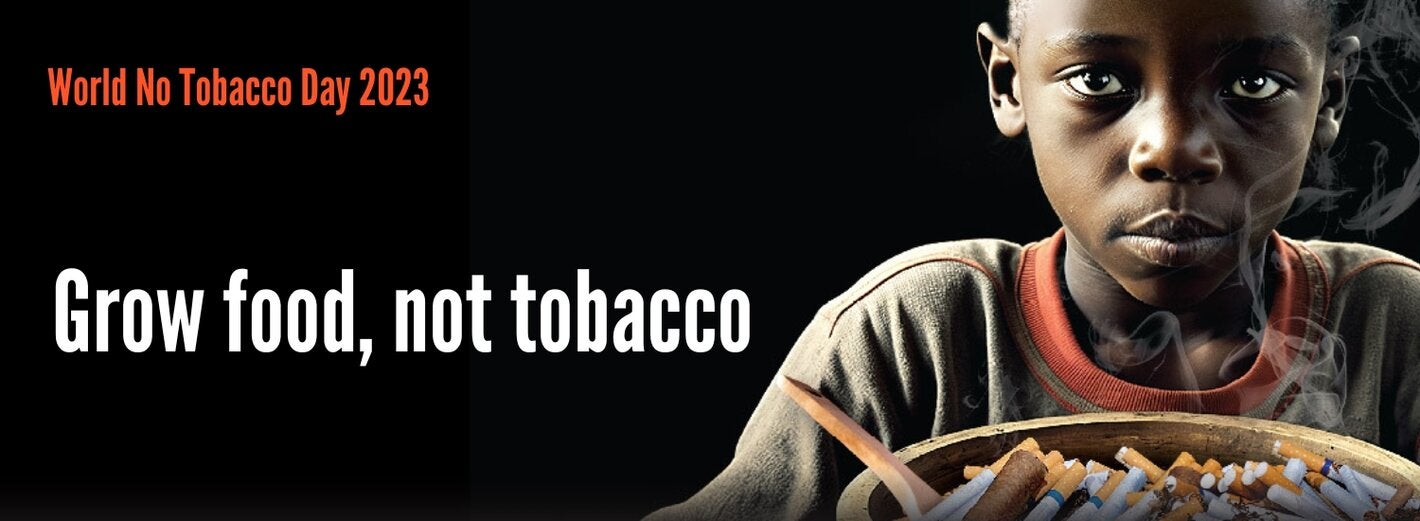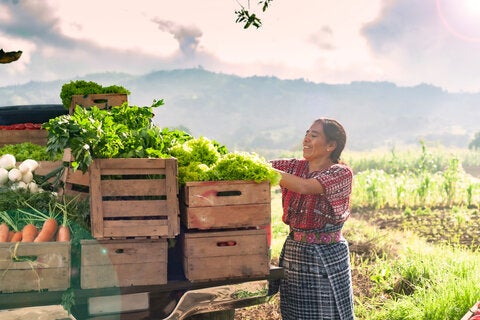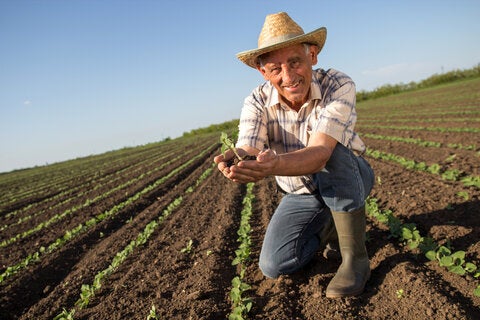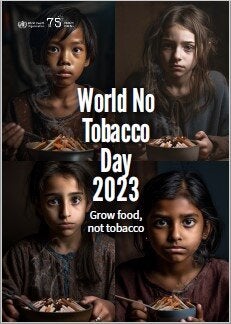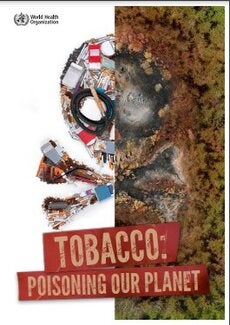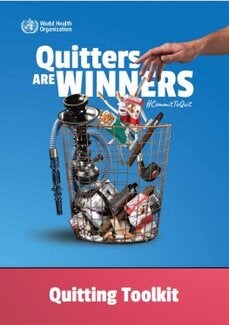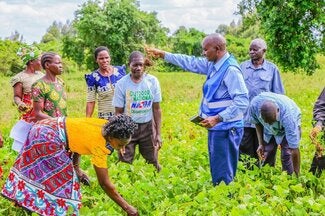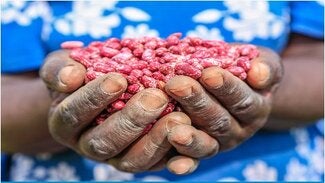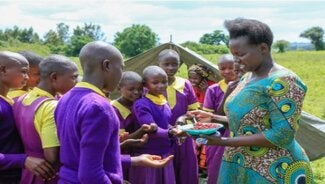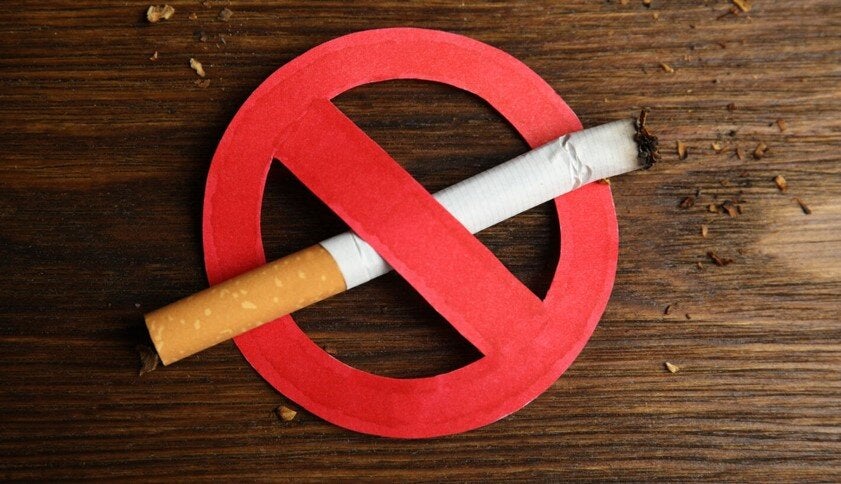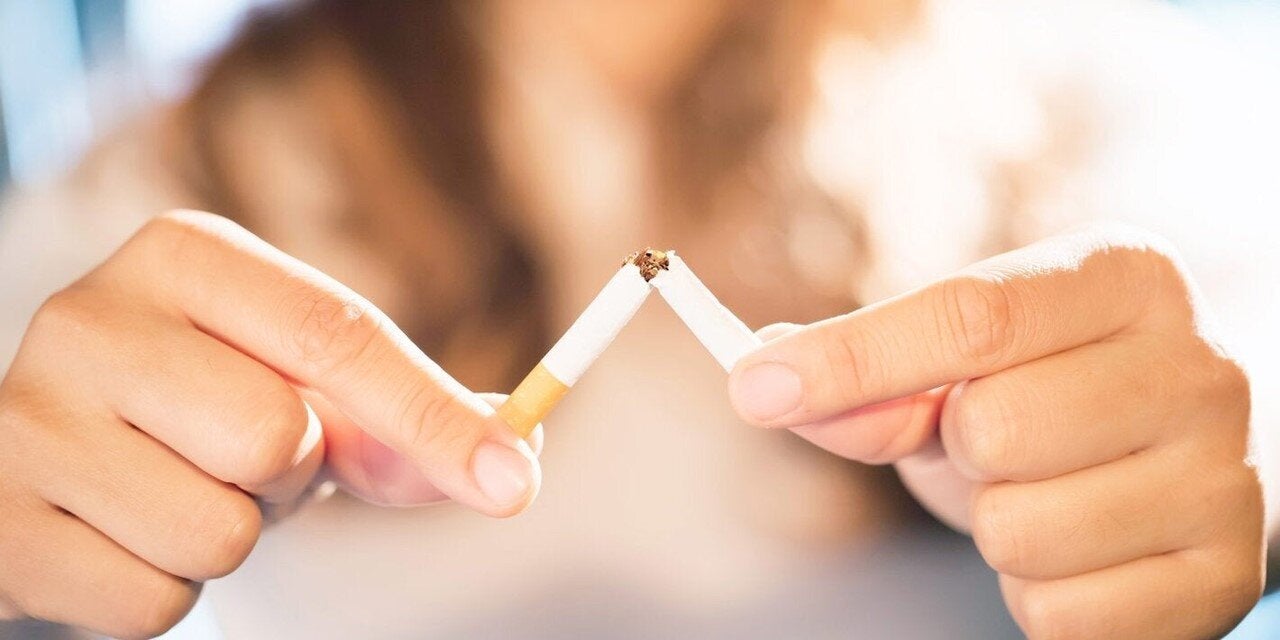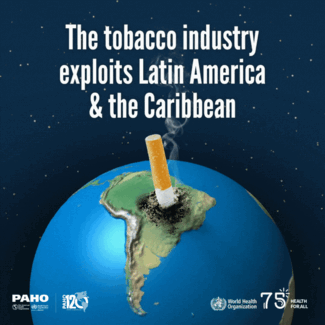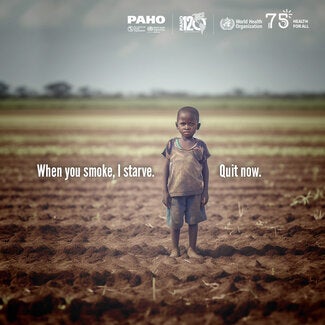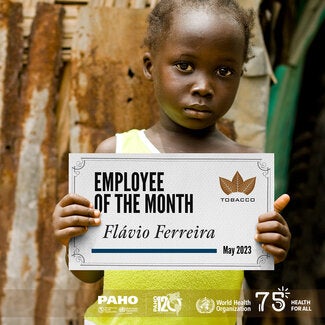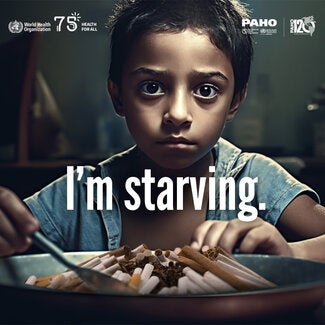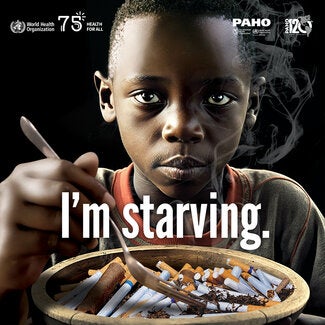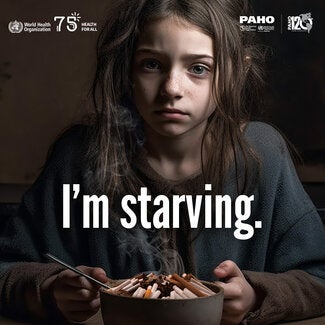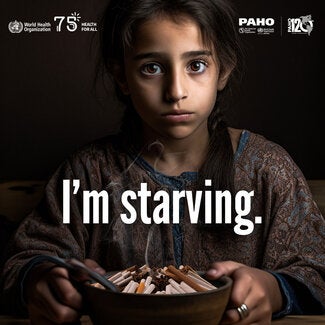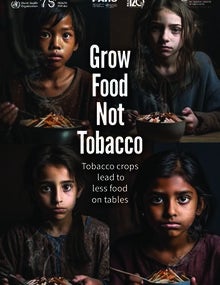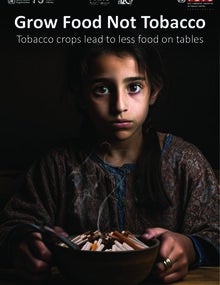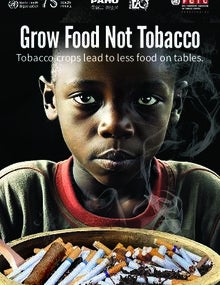Grow food, not tobacco
Tobacco growing harms our health, the health of farmers and the planet’s health. The tobacco industry interferes with attempts to substitute tobacco growing, contributing to the global food crisis.
This campaign encourages governments to end tobacco growing subsidies and use the savings to support farmers to switch to more sustainable crops that improve food security and nutrition.
Campaign objectives
- Mobilize governments to end subsidies on tobacco growing and use of savings for crop substitution programmes that support farmers to switch and improve food security and nutrition.
- Raise awareness in tobacco farming communities about the benefits of moving away from tobacco and growing sustainable crops;
- Support efforts to combat desertification and environmental degradation by decreasing tobacco farming;
- Expose industry efforts to obstruct sustainable livelihoods work.
The key measure of campaign success would be the number of governments that pledge to end subsidies on tobacco growing.
MESSAGE BY DR. JARBAS BARBOSA, PAHO DIRECTOR
Governments should accelerate the implementation of Articles 17 and 18 of the WHO Framework Convention on Tobacco Control and its guidelines that outline how governments can support farmers by offering technical advice on agriculture to farmers, linking them to necessary supplies and services to support their agricultural production, providing financial support to increase production of healthy food, and divesting away from tobacco and towards alternative crops.
- Seek political support for programmes to support farmers to shift to alternative livelihoods.
- Initial subsidies of supplies (quality seeds, fertilizers or farm equipment) to incentivize famers to make the shift until they have the financial means to sustain it on their own, especially given that supplies are a key factor in farmers’ decision to enter into contract with tobacco leaf buying companies.
- Extension services in the form of training and technical advice on agriculture, as well as support for farmers to access the necessary supplies and services for agricultural production, thereby increasing income.
- Programmes to better connect farmers to buyers of healthy, resilient, local and sustainable crops, so that they can be assured a viable market when moving away from tobacco.
- Support the development of farmers’ cooperatives to help in creating a robust information exchange and knowledge transfer mechanism and mitigate risk for shifting to non-tobacco crops.
- Support diversification strategies that are demand driven and pursue policies based on market dynamics.
- Hold the tobacco industry accountable for the risks posed to the environment and the health effects of tobacco cultivation and manufacturing.
- Working with government departments of public health and local government officials to sensitize farmers to the benefits of shifting away from tobacco and what alternatives are available.
- Develop community-based champions to lead the shift.
Read more on country practices in the implementation of Article 17 here.
Governments should recognize the additional burden placed on low- and middle-income countries to grow tobacco for consumption in high-income countries. High income countries that import tobacco need to incorporate tobacco control, including for alternative livelihoods to tobacco, as part of their development cooperation strategies. They must support alternative livelihood to tobacco growing initiatives which align with other commitments to support the health, environment and economies of low- and middle-income countries and least developed countries.
Groups should develop and share global and regional best practices, as well as educational programmes and information campaigns backed by data and evidence to prevent any attempt of the tobacco industry to misinform farmers and to help promote viable options available to tobacco growers and workers to shift to sustainable alternative livelihoods. They can also generate awareness amongst farmers to understand the negative health, environmental, social and economic effects associated with tobacco growing.
For example, various initiatives under the Digital India Programme by the Government such as “Digital Village”,”Common Service Centres”, “e-Health”, e-education” etc. can be used for education, awareness and advocacy for tobacco farmers.
Advocates are encouraged to call out the government for supporting tobacco production in low- and middle-income/least developed countries, especially those that are facing food insecurity and contributing to global food crisis, and for not walking the talk on tobacco control including alternative livelihoods as part of development cooperation.
Civil society organizations can expose industry efforts to impede efforts to support tobacco farmers to shift to alternative livelihoods as well as their efforts to greenwash their tactics.
Microfinance institutions can ensure that rural credit programmes benefit tobacco growers who are looking to shift so they can be supported to purchase inputs needed to grow alternative crops.
UN Agencies should work together to address SDG Targets 2.1, 2.2, 2.3 and 2.4 (improve food security and nutrition), SDG Target 3a (implementation of WHO FCTC), SDG Target 13 (combat climate change) and SDG Target 17 (strengthen partnership for sustainable development). This can be achieved by establishing enabling crop production and marketing ecosystems to support farmers to shift from tobacco to alternative crops.
Private sector market players can help shape the market for sustainable alternative crops by incentivizing farmers who shift by providing support along the value chain, including on inputs, post-harvest handling, aggregation and offtake.
Questions and answers
A record 349 million people across 79 countries are facing acute food insecurity, many are in low- and middle-income countries. Over 30 are on the African continent. Many of these countries use large areas of fertile land to grow tobacco rather than healthy food. Tobacco growing countries often face a negative economic impact due to the adverse health, environmental and social impacts of growing tobacco. In many cases, foreign exchange earned from tobacco exports is used to import food. Growing tobacco causes ill health among farmers and farm workers and irreversible environmental loss of precious resources such as water sources, forests, plants and animal species.
Tobacco is grown in over 124 countries as a cash crop, using an estimated 3.2 million hectares of fertile land.
The top 3 tobacco leaf growers (China, Brazil and India, in order of production) account for over 60% of global production. As regulations tighten in middle- and high-income countries, tobacco companies are increasingly targeting African countries to scale-up tobacco leaf production.
- Green tobacco sickness. As many as 1 in 4 tobacco farmers are affected by green tobacco sickness, nicotine poisoning. The disease is caused by nicotine absorbed through the skin from the handling of tobacco leaves. Symptoms include nausea, vomiting, dizziness, headaches, increased perspiration, chills, abdominal pain, diarrhoea, weakness, breathlessness and more.
- Exposure to heavy chemicals and nicotine. Tobacco farmers are exposed daily to tobacco dust and other chemical pesticides. A tobacco farmer who plants, cultivates and harvests tobacco may absorb nicotine equivalent to 50 cigarettes per day. Additionally, tobacco farmers often carry harmful substances home on their bodies, clothes or shoes, leading to secondary harmful exposures for their families, especially children.
- Chronic lung conditions. Tobacco farmers also inhale large amounts of tobacco smoke during the curing process, which increases the risk of chronic lung conditions and other health challenges.
- Vulnerable populations especially at risk. Women and children are often the primary tobacco labourers and are therefore more exposed to the health risks of handling green tobacco leaves and heavy chemicals as well as exposure to tobacco smoke during the curing process. Children are particularly vulnerable, given their body weight relative to the proportion of nicotine absorbed through their skin. Pregnant women are also disproportionally affected by the harmful effects of tobacco farming and face a higher risk of miscarriage. People who roll bidis (hand rolled cigarettes), especially women and children, get exposed to tobacco dust, which they inhale while stocking the tobacco at home and rolling-bidis, resulting in respiratory diseases and other health issues.
- Heavy use of pesticides. Tobacco growing is resource-intensive and requires heavy use of pesticides and fertilizers, which contribute to soil degradation. These chemicals escape into the aquatic environment, contaminating lakes, rivers and drinking water. Land used for growing tobacco then has a lower capacity for growing other crops, such as food, since tobacco depletes soil fertility.
- Deforestation. Tobacco farming accounts for about 5% of total deforestation, further contributing to CO2 emissions and climate change. To make space for tobacco crops, trees must be cut down and land cleared. It takes roughly one tree to make 300 cigarettes. This leads to desertification and hunger as there is limited fertile land to grow food in some of these regions. Approximately 200 000 hectares (ha) of land are cleared for tobacco agriculture and curing each year, which is the equivalent of almost half the area of Cape Verde (403 000 ha).
- Loss of biodiversity. Tobacco growing contributes to habitat fragmentation, meaning that parts of the habitat are destroyed leaving smaller unconnected areas, which can undermine ecosystems and contribute to loss of biodiversity. It is also associated with land degradation or desertification in the form of soil erosion, reduced soil fertility and productivity, and the disruption of water cycles. Leaching of chemicals into nearby water sources kills fish and affects other humans and animals, including cattle, that access these waters for domestic use and drinking.
- Scarcity of quality land. Quality land is increasingly being used for tobacco growing in low- and middle-income countries, reducing the amount of land that could be used for crops to nourish people.
- Limited choice of alternatives. Choices of alternative crops are sometimes limited due to absence of strong assured markets as compared to the tobacco market, as well as of government support to transition away from tobacco growing.
- Degrading of soil. The tobacco plant and the chemicals required to grow it degrade the soil, and intercropping – the practice of growing two or more crops in close proximity – is a challenge as the soil is depleted of essential nutrients for productive farming.
- Crop intensity. Tobacco is a labour-intensive crop that takes up to 9 months to mature, which makes it difficult for smallholder farmers to grow food crops within the same year.
- Debt. Growing tobacco requires access to supplies and services, such as seed and fertilizer, at the start of the season. The tobacco industry advances these costs, which are then deducted from their payment at the end of the season. Through this process, farmers end up in dependency and debt to transnational tobacco companies or intermediary traders.
- Under-grading and under-pricing of tobacco leaf. Smallholder farmers in low- and middle-income countries are often contracted to grow tobacco through legal agreements with large transnational companies where the tobacco prices and grades (or quality) are determined by the buyer, leaving farmers little room for negotiation. Transnational tobacco companies forcibly reduce their costs through under-grading, and therefore under-pricing, of farmers’ tobacco leaf. The contractors also determine the cost of the inputs and they are inevitably inflated, further disadvantaging the farmers.
- Labour intensity. Tobacco growing is a labour-intensive practice, requiring farmers and their families to spend most of their day tending to the plants. The well-documented labour intensiveness of tobacco farming largely explains why smallholder tobacco farmers generally earn very little considering their efforts. When all the days worked by every contributing household member are included, studies show that tobacco farming is less profitable than other crops. Research across several countries suggests that this labour would be more valuable growing other crops.
- Cost of inputs. The cost of seeds, fertilizers, fuel wood and renting or buying land are expensive and often not factored in when assessing the profitability of tobacco growing.
- Healthcare costs. Tobacco growing burdens farmers with health issues that can be unique to tobacco growing, such as green tobacco sickness, increasing the overall household healthcare costs.
Trapping farmers in a cycle of debt. The tobacco industry keeps farmers dependent by providing them with incentives, such as loans or supplies needed to grow tobacco like seeds and agrochemicals. Often under contractual arrangements with the tobacco industry, farmers are then trapped in a vicious circle of debt, unable to get a fair price for their product. Tobacco companies are able to do this because there is a lack of rural credit available.
- Greenwashing their tactics. Philip Morris International (PMI) launched a zero deforestation and no natural ecosystem conversion programme operated to protect natural habitats, particularly biodiversity sites of global importance and protected areas in 2022. Meanwhile, tobacco accounts for about 5% of total deforestation.
- Corporate responsibility schemes. The tobacco industry has set up several organizations and programmes which aim to support the livelihoods of tobacco-growing communities through crop diversification methods and schemes that aim to improve living standards of farmers. Introducing new crops while continuing to grow tobacco does not eliminate the risks of tobacco growing. These efforts divert public attention away from the real costs of tobacco farming such as poor health outcomes, environmental degradation and poverty.
- Corporate responsibility schemes. The tobacco industry has set up several organizations and programmes which aim to support the livelihoods of tobacco-growing communities through crop diversification methods and schemes that aim to improve living standards of farmers. Introducing new crops while continuing to grow tobacco does not eliminate the risks of tobacco growing. These efforts divert public attention away from the real costs of tobacco farming such as poor health outcomes, environmental degradation and poverty.
- Corporate responsibility schemes. The tobacco industry has set up several organizations and programmes which aim to support the livelihoods of tobacco-growing communities through crop diversification methods and schemes that aim to improve living standards of farmers. Introducing new crops while continuing to grow tobacco does not eliminate the risks of tobacco growing. These efforts divert public attention away from the real costs of tobacco farming such as poor health outcomes, environmental degradation and poverty.
- In many tobacco growing countries, governments provide direct subsidies to tobacco farmers. In several countries, it is easy to get crop loans (or get crop insurance) for tobacco crops, sometimes with no collateral.
- Direct subsidies often incentivize and influence farmers to grow tobacco crops only because of the subsidies. As a result, more tobacco is produced than can be absorbed by the free market. Not only does this undermine the livelihoods of farmers, but it also costs government more money and drives the prices of tobacco down.
- Available data from the World Trade Organization demonstrate that several countries offer direct tobacco subsidies, including some high-income countries like the United States of America and Switzerland (US$ 142.8 million and US$ 4.57 million (4.2 million Sw.fr.) in 2021, respectively). In 2020, the government of Macedonia spent roughly US$ 32 million (€30 million) on tobacco subsidies.
- Available data from the World Trade Organization demonstrate that several countries offer direct tobacco subsidies, including some high-income countries like the United States of America and Switzerland (US$ 142.8 million and US$ 4.57 million (4.2 million Sw.fr.) in 2021, respectively). In 2020, the government of Macedonia spent roughly US$ 32 million (€30 million) on tobacco subsidies.
Tobacco-Free Farms is a joint initiative of the World Health Organization, World Food Programme and Food and Agriculture Organization, in collaboration with the Ministry of Health and Ministry of Agriculture, that has launched in Kenya. The initiative aims to create an enabling and supportive crop production and marketing ecosystem to help farmers shift from tobacco growing to alternative livelihoods. Roughly 1500 farmers have shifted to growing high-iron beans, but other good alternatives to tobacco include sorghum, millet and sweet potato. More on the initiative here.
Governments in tobacco growing countries. Governments should accelerate the implementation of Articles 17 and 18 of the WHO Framework Convention on Tobacco Control and its guidelines that outline how governments can support farmers by offering technical advice on agriculture to farmers, linking them to necessary supplies and services to support their agricultural production, providing financial support to increase production of healthy food, and divesting away from tobacco and towards alternative crops.
- Seek political support for programmes to support farmers to shift to alternative livelihoods.
- Initial subsidies of supplies (quality seeds, fertilizers or farm equipment) to incentivize famers to make the shift until they have the financial means to sustain it on their own, especially given that supplies are a key factor in farmers’ decision to enter into contract with tobacco leaf buying companies.
- Extension services in the form of training and technical advice on agriculture, as well as support for farmers to access the necessary supplies and services for agricultural production, thereby increasing income.
- Programmes to better connect farmers to buyers of healthy, resilient, local and sustainable crops, so that they can be assured a viable market when moving away from tobacco.
- Support the development of farmers’ cooperatives to help in creating a robust information exchange and knowledge transfer mechanism and mitigate risk for shifting to non-tobacco crops.
- Support diversification strategies that are demand driven and pursue policies based on market dynamics.
- Hold the tobacco industry accountable for the risks posed to the environment and the health effects of tobacco cultivation and manufacturing.
- Working with government departments of public health and local government officials to sensitize farmers to the benefits of shifting away from tobacco and what alternatives are available.
- Develop community-based champions to lead the shift.
Read more on country practices in the implementation of Article 17 here.
Governments in countries that do not grow tobacco and only import tobacco leaf. Governments should recognize the additional burden placed on low- and middle-income countries to grow tobacco for consumption in high-income countries. High income countries that import tobacco need to incorporate tobacco control, including for alternative livelihoods to tobacco, as part of their development cooperation strategies. They must support alternative livelihood to tobacco growing initiatives which align with other commitments to support the health, environment and economies of low- and middle-income countries and least developed countries
Advocacy groups in tobacco growing countries. Groups should develop and share global and regional best practices, as well as educational programmes and information campaigns backed by data and evidence to prevent any attempt of the tobacco industry to misinform farmers and to help promote viable options available to tobacco growers and workers to shift to sustainable alternative livelihoods. They can also generate awareness amongst farmers to understand the negative health, environmental, social and economic effects associated with tobacco growing.
For example, various initiatives under the Digital India Programme by the Government such as “Digital Village”,”Common Service Centres”, “e-Health”, e-education” etc. can be used for education, awareness and advocacy for tobacco farmers.
Advocates from tobacco importing countries. Advocates are encouraged to call out the government for supporting tobacco production in low- and middle-income/least developed countries, especially those that are facing food insecurity and contributing to global food crisis, and for not walking the talk on tobacco control including alternative livelihoods as part of development cooperation.
Civil society. Civil society organizations can expose industry efforts to impede efforts to support tobacco farmers to shift to alternative livelihoods as well as their efforts to greenwash their tactics.
Microfinance institutions. Microfinance institutions can ensure that rural credit programmes benefit tobacco growers who are looking to shift so they can be supported to purchase inputs needed to grow alternative crops.
UN Agencies. UN Agencies should work together to address SDG Targets 2.1, 2.2, 2.3 and 2.4 (improve food security and nutrition), SDG Target 3a (implementation of WHO FCTC), SDG Target 13 (combat climate change) and SDG Target 17 (strengthen partnership for sustainable development). This can be achieved by establishing enabling crop production and marketing ecosystems to support farmers to shift from tobacco to alternative crops.
Private sector market players. Private sector market players can help shape the market for sustainable alternative crops by incentivizing farmers who shift by providing support along the value chain, including on inputs, post-harvest handling, aggregation and offtake.
Other resources
Tobacco: poisoning our planet
WHO Quitting Toolkit
WHO resources for quitting
Florence: the digital resource that helps to quit tobacco
Launch of tobacco-free farms in Kenya
Tobacco tactics. University of Bath
UN News: Seeds of change in Kenya as farmers lead way on tobacco free farms
Unfair Tobacco – Case studies on alternative livelihoods for tobacco
Farmer testimonials
Tobacco free farming in Kenya: Reginald Omulo
Tobacco free farming in Kenya: Alice Achieng Obare

